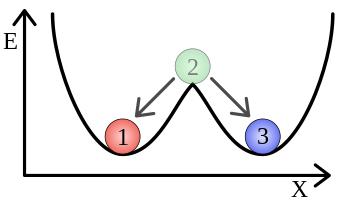Bistability

Bistability is a fundamental phenomenon in nature. Something that is bistable can be resting in two states. Note that these rest states need not be symmetric with respect to stored energy. The defining characteristic of bistability is simply that two stable states (minima) are separated by a peak (maximum).
In physics, for an ensemble of particles, the bistability comes from the fact that its free energy has three critical points. Two of them are minima and the last is a maximum. By mathematical arguments, the maximum must lie between the two minima. By default, the system state will be in either of the minima states, because that corresponds to the state of lowest energy. The maximum can be visualised as a barrier.
A transition from one state of minimal free energy requires some form of activation energy to penetrate the barrier (compare activation energy and Arrhenius equation for the chemical case.) After the barrier has been reached, the system will relax into the next state of lowest energy again. The time it takes is usually attributed the relaxation time. (There might be uncertainty as to which state will be the new one, but it is often well defined in the situation.)
Optical bistability is an attribute of certain optical devices where two resonant transmissions states are possible and stable, dependent on the input.
Bistability is key for understanding basic phenomena of cellular functioning, such as decision-making processes in cell cycle progression, cellular differentiation, and apoptosis. It is also involved in loss of cellular homeostasis associated with early events in cancer onset and in prion diseases as well as in the origin of new species (speciation) [1].
Bistability can only arise in biological and chemical systems if three necessary conditions are fulfilled: positive feedback, a mechanism to filter out small stimuli and a mechanism to prevent explosions [1].
Bistable chemical systems have been studied extensively to analyse relaxation kinetics, non-equilibrium thermodynamics, stochastic resonance, as well as climate change [1].
Bistability is often accompanied by hysteresis. On a population level, if many realisations of a bistable system are considered (e.g. many bistable cells), one typically observes bimodal distributions.
In Mechanical Systems
Bistability as applied in the design of mechanical systems is more commonly said to be "over center" -- that is, work is done on the system to move it just past the peak, at which point the mechanism goes "over center" to its secondary stable position. The result is a toggle-type action. An especially common method of achieving an "over center" action is to use a spring.
As an example of a common over center device, a ratchet_(device) goes over center as it is turned in the forward direction. In this case, "over center" refers to the ratchet being stable and "locked' in a given position until clicked forward again; it has nothing to do with the ratchet being unable to turn in the reverse direction. Position "1" and position "2" in the figure above could be read as "current tooth" and "next tooth."
References
- ^ a b c Wilhelm, T (2009). "The smallest chemical reaction system with bistability". BMC Systems Biology. 3: 90. doi:10.1186/1752-0509-3-90.
{{cite journal}}: CS1 maint: unflagged free DOI (link)
See also
- ferroelectric, ferromagnetic, hysteresis, bistable perception
- astable multivibrator, monostable multivibrator.
- Schmitt trigger
- strong Allee effect
- Multistable perception describes the spontaneous or exogenous alternation of different percepts in face of the same physical stimulus.
- Interferometric modulator display, a bistable reflective display technology found in mirasol displays by Qualcomm
